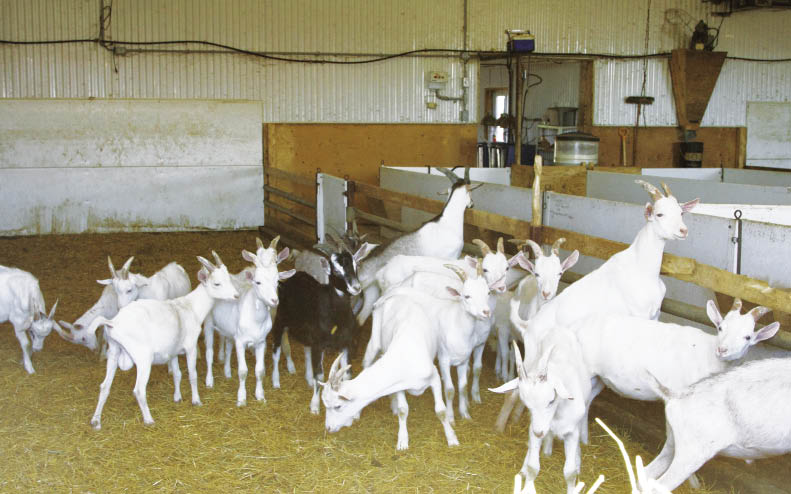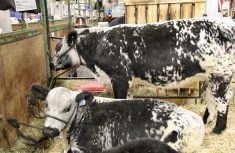Cow-calf producer Brian Pelleboer and his wife, Joan, were hit hard by BSE, taking a financial hit that amounted to a quarter-million dollars. It took them five years to recover. The point is, though, that they did recover. Beef farming, it would seem, is about resilience. It’s about bouncing back, and making the most of everything you’ve got. The Pelleboers knew if they were to have a viable, profit-generating business, something needed to change. What their farm needed was a little diversification and something Brian likes to call “a complementary system.”
Read Also

Body condition, nutrition and vaccination for brood cows
One of the remarkable events of the past century related to ranching has been the genetic evolution of brood cows….
Diversifying the farm
It happened by accident really. He certainly didn’t mean to go into dairy goats. It just sort of happened. After a neighbour said that he was getting out of the industry, the next thing Pelleboer knew, he had bought the neighbour’s herd.
“When I first bought the goat herd, I didn’t tell anybody because I thought myself I was a little bit crazy,” he says. “I knew it could be done and I wanted to do it, but I was almost afraid to tell anybody what I was doing because I thought they’d think I was a fool.”
As it turns out, Pelleboer was on to something. The dairy goat industry is both stable and profitable — a trend that doesn’t show signs of slowing either. In fact, according to Statistics Canada (2011), the sector has grown 300 per cent in the past five years. It’s the perfect combination of high demand and low competition.
Labour intensive, but worth it
The Pelleboers milk 250 commercial dairy goats, making their operation medium size. Milk is used for a wide variety of products, including chevre, feta and yogurt. Most of the Pelleboers’ milk, though, goes to Woolwich Dairy Inc. in Orangeville.
The operation is quite labour intensive. Dairy goats are seasonal breeders, but processors want milk year round. Meeting those demands can be challenging. “It’s seven days a week… a definite commitment,” says Pelleboer. “But it’s worth it.”
As one of the 113 members of the Ontario Dairy Goat Cooperative, Pelleboer says that he, along with the others, is responsible for marketing and transportation. It’s a challenge they accept readily.
“We sell our milk through a co-operative,” he continues. “And we market our milk directly to the processor. We have our own trucks, and we truck it all, so we’re basically the brokers of our own milk, which is quite unique if you look at the cattle business.”
A complementary system
Success isn’t about finding something that “sorta” works and sticking with it, says Brian. It’s about fine tuning your system until you find something that really works. It’s about seeking balance and maximizing dollars.
“I’ve been doing cattle for 25 to 30 years,” says Pelleboer. “I’ve done just about everything that could be done. There’s not that much new in the cattle industry.”
The dairy goat industry, by contrast, is young, he says. “There’s so much potential out there for growth in almost every area. Feed, genetics, marketing — everything is basically untapped.”
The Pelleboers are still raising 100 head of cattle. In fact, Brian says the cattle are an integral part of the system. The cows and goats complement one another, he says, particularly when it comes to feed.
The Pelleboers’ goats and cows eat the same diet — haylage and corn silage. Most dairy goat farmers operate differently, though, feeding their goats a mixture of pelleted rations and straw that they buy in.
“They have to get the big milk yields out of their goats to pay the feed bills,” he says. “For me, when I get my milk cheque, I don’t have a lot of feed bills.”
With goats, says Pelleboer, the more dry matter they take in, the more milk they produce. But goats are particular about what they eat. They prefer fresh feed, rejecting anything that’s slightly spoiled. The cows, on the other hand, will eat most anything you put in front of them.
To keep the goats eating, Pelleboer puts 10-20 per cent more feed in front of them than they can actually eat. On a dairy goat-only operation, that excess food would go to waste, but on his farm the cattle eat the leftovers.
“Contrary to what people think goats are really fussy about what they eat. Although, they’d probably eat the clothes off the line if they got out, but that’s just because they’re curious,” he laughs.
“Because I have the cows, the feed is fresher in the bunk silo,” says Pelleboer, “The cows take a large volume of feed. They both get fed out of the same bunker, so if I can feed out of that storage facility quicker, it keeps the feed fresher and therefore, the best part goes to the goats. The little bit of spoilage goes to the cattle, so nothing’s wasted.”
It’s not just feed, though. It’s equipment, too. Aside from the equipment needed for the milking parlour, most everything on the farm is used for both sides of their operation.
“You make what you have work, and you try to get the most out of everything you have,” says Pelleboer. “It wasn’t a big plan or scheme of mine that I had all figured out from Day 1 before I started. It just happened. You ask yourself, ‘How can I do this better?’ and you start thinking about your whole operation. You think, well, hey, I can do this and I can do that. It works out good for my cows, and it works out good for my goats, and works out good for my equipment.
“My whole farm is a team player,” he continues. “I’m just kinda in the middle orchestrating it all.”
Perhaps the best thing about the Pelleboers’ farm, though, is that it is now viable. “If one of my kids comes home and decides that they want to farm, there’s a profitable entity here that they can go to the bank with. The cattle…” he pauses. “I don’t think they can. When I’m done here, because of the goats, someone can actually make it work.” c
















